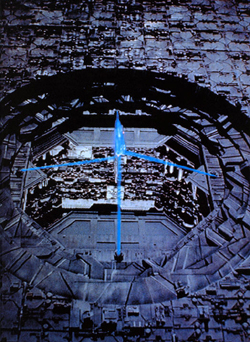Dyson Sphere
From Starbase 900 Wiki
Starfleet dispatched several science vessels to the sphere after the Enterprise discovered a Dyson Sphere, and has been investigating it for a while now. Certainly the greatest feat of engineering known to exist, physical data regarding the Dyson sphere tends to consist of extremes. It has a diameter of two hundred million kilometers - approximately two thirds the size of the Earths orbit around its sun. The total enclosed volume is 4.19 x 1024 km3, while with an average thickness of 2,400 meters the total volume of the spheres structure itself is some 3.02 x 1017 km3.
The interior surface has an area of over 1.25 x 1017 km2, which is equal to some 245 million average class M planets. Statistical studies indicate that there are some 20 million class M planets in our galaxy - making the sphere over twelve times greater in area than every inhabitable planet in the galaxy put together. Initial studies of the interior indicate that the surface was class M, consisting of about 40% land and 60% water. Studies of the size and density of population centers indicate an average population density on land of 15 people per km2; this approximately one quarter the current population density of the Earths land area. If this truly does represent the average population density of the whole land area of the sphere, then it would hold up to 3,000,000,000,000,000,000 people. The interior environment would be somewhat strange to a person used to living on a planet; there is no night-day cycle within the sphere, nor are there any seasons or other natural cycles.
So far comparatively little of the technology of the sphere builders has been discovered; they apparently removed most of it when they abandoned the sphere. So far studies of the technology have centered on the materials technology, the structural integrity system and the artificial gravity network which lies beneath the spheres surface. Little progress has been made on the former front; the sphere is made of a variety of materials, many of them unknown; the basic structure is made of carbon-neutronium, a material which combines the density of the diamond form of carbon with the strength of neutronium. It has proven extremely difficult to subject this material to testing because of its virtual invulnerability to most testing methods, and so far nothing has been learned about its manufacture or practical methods of utilizing it. Research into the structural integrity technology has yielded better results; the SIF systems used on the Dyson sphere are not all that dissimilar to those in use in the Federation, although they are on a vastly larger scale both in terms of the power of individual systems and the number of those systems. Some interesting systems have been uncovered, and this technology is currently at the Alien Technology Evaluation Center of this institute to determine if it can be applied to Federation vessels and structures.
The gravity field generators are also yielding some interesting results; the system not only provides for a 0.895 gravity environment on the interior surface, but it is also apparently the main method of radiating energy into space. Under normal circumstances a Dyson sphere would act much like a massive greenhouse, containing the entire energy output of the star within it until the surface temperature reached a point at which conduction and radiation processes through and away from the surface could send the heat into space. The sphere builders have apparently overcome this process by using the waste heat produced to power the gravity generator network; this energy is then radiated harmlessly into space. While this rather neatly solves the thermal problem, it does ensure that the sphere is an source of intense gravimetric interference which can make it difficult to operate warp drives and sensors in the area around it.
